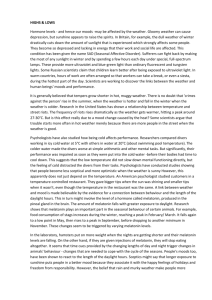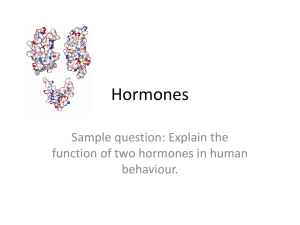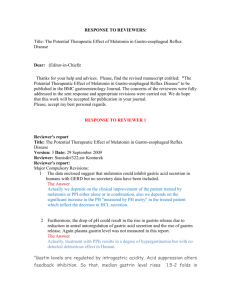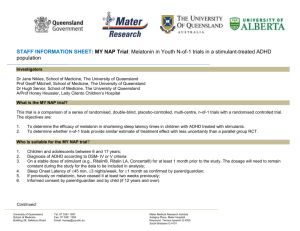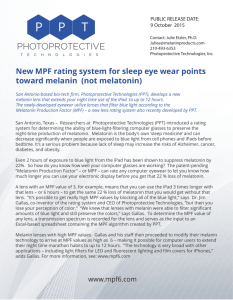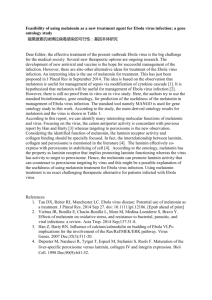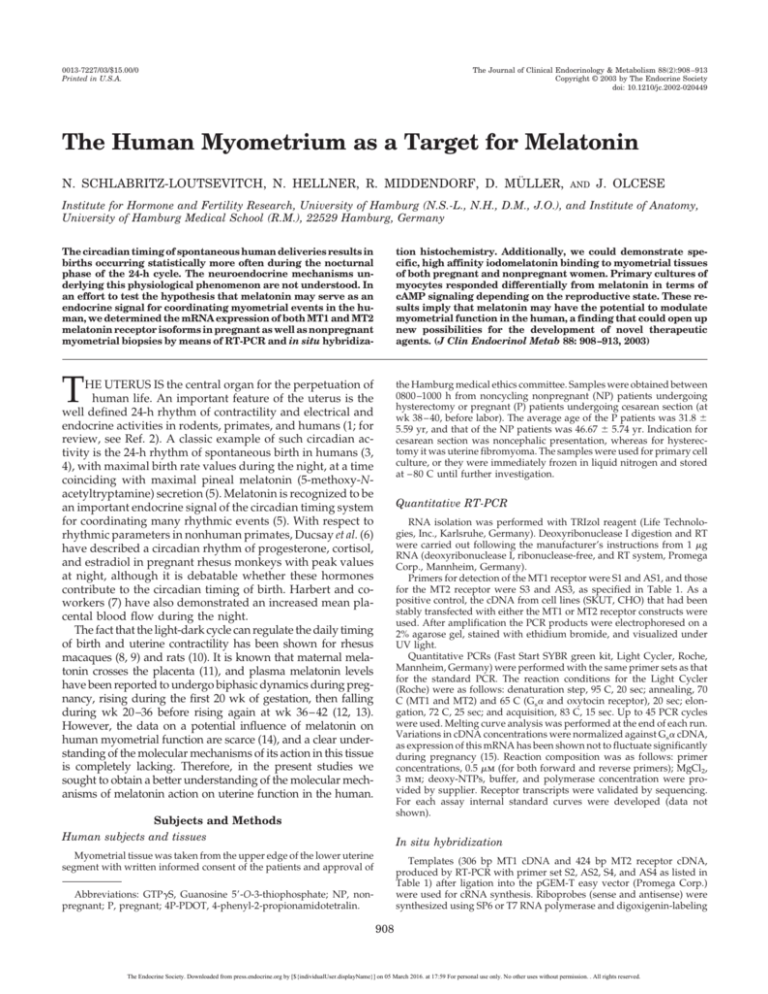
0013-7227/03/$15.00/0
Printed in U.S.A.
The Journal of Clinical Endocrinology & Metabolism 88(2):908 –913
Copyright © 2003 by The Endocrine Society
doi: 10.1210/jc.2002-020449
The Human Myometrium as a Target for Melatonin
N. SCHLABRITZ-LOUTSEVITCH, N. HELLNER, R. MIDDENDORF, D. MÜLLER,
AND
J. OLCESE
Institute for Hormone and Fertility Research, University of Hamburg (N.S.-L., N.H., D.M., J.O.), and Institute of Anatomy,
University of Hamburg Medical School (R.M.), 22529 Hamburg, Germany
The circadian timing of spontaneous human deliveries results in
births occurring statistically more often during the nocturnal
phase of the 24-h cycle. The neuroendocrine mechanisms underlying this physiological phenomenon are not understood. In
an effort to test the hypothesis that melatonin may serve as an
endocrine signal for coordinating myometrial events in the human, we determined the mRNA expression of both MT1 and MT2
melatonin receptor isoforms in pregnant as well as nonpregnant
myometrial biopsies by means of RT-PCR and in situ hybridiza-
tion histochemistry. Additionally, we could demonstrate specific, high affinity iodomelatonin binding to myometrial tissues
of both pregnant and nonpregnant women. Primary cultures of
myocytes responded differentially from melatonin in terms of
cAMP signaling depending on the reproductive state. These results imply that melatonin may have the potential to modulate
myometrial function in the human, a finding that could open up
new possibilities for the development of novel therapeutic
agents. (J Clin Endocrinol Metab 88: 908 –913, 2003)
T
HE UTERUS IS the central organ for the perpetuation of
human life. An important feature of the uterus is the
well defined 24-h rhythm of contractility and electrical and
endocrine activities in rodents, primates, and humans (1; for
review, see Ref. 2). A classic example of such circadian activity is the 24-h rhythm of spontaneous birth in humans (3,
4), with maximal birth rate values during the night, at a time
coinciding with maximal pineal melatonin (5-methoxy-Nacetyltryptamine) secretion (5). Melatonin is recognized to be
an important endocrine signal of the circadian timing system
for coordinating many rhythmic events (5). With respect to
rhythmic parameters in nonhuman primates, Ducsay et al. (6)
have described a circadian rhythm of progesterone, cortisol,
and estradiol in pregnant rhesus monkeys with peak values
at night, although it is debatable whether these hormones
contribute to the circadian timing of birth. Harbert and coworkers (7) have also demonstrated an increased mean placental blood flow during the night.
The fact that the light-dark cycle can regulate the daily timing
of birth and uterine contractility has been shown for rhesus
macaques (8, 9) and rats (10). It is known that maternal melatonin crosses the placenta (11), and plasma melatonin levels
have been reported to undergo biphasic dynamics during pregnancy, rising during the first 20 wk of gestation, then falling
during wk 20 –36 before rising again at wk 36 – 42 (12, 13).
However, the data on a potential influence of melatonin on
human myometrial function are scarce (14), and a clear understanding of the molecular mechanisms of its action in this tissue
is completely lacking. Therefore, in the present studies we
sought to obtain a better understanding of the molecular mechanisms of melatonin action on uterine function in the human.
the Hamburg medical ethics committee. Samples were obtained between
0800 –1000 h from noncycling nonpregnant (NP) patients undergoing
hysterectomy or pregnant (P) patients undergoing cesarean section (at
wk 38 – 40, before labor). The average age of the P patients was 31.8 ⫾
5.59 yr, and that of the NP patients was 46.67 ⫾ 5.74 yr. Indication for
cesarean section was noncephalic presentation, whereas for hysterectomy it was uterine fibromyoma. The samples were used for primary cell
culture, or they were immediately frozen in liquid nitrogen and stored
at – 80 C until further investigation.
Quantitative RT-PCR
RNA isolation was performed with TRIzol reagent (Life Technologies, Inc., Karlsruhe, Germany). Deoxyribonuclease I digestion and RT
were carried out following the manufacturer’s instructions from 1 g
RNA (deoxyribonuclease I, ribonuclease-free, and RT system, Promega
Corp., Mannheim, Germany).
Primers for detection of the MT1 receptor were S1 and AS1, and those
for the MT2 receptor were S3 and AS3, as specified in Table 1. As a
positive control, the cDNA from cell lines (SKUT, CHO) that had been
stably transfected with either the MT1 or MT2 receptor constructs were
used. After amplification the PCR products were electrophoresed on a
2% agarose gel, stained with ethidium bromide, and visualized under
UV light.
Quantitative PCRs (Fast Start SYBR green kit, Light Cycler, Roche,
Mannheim, Germany) were performed with the same primer sets as that
for the standard PCR. The reaction conditions for the Light Cycler
(Roche) were as follows: denaturation step, 95 C, 20 sec; annealing, 70
C (MT1 and MT2) and 65 C (Gs␣ and oxytocin receptor), 20 sec; elongation, 72 C, 25 sec; and acquisition, 83 C, 15 sec. Up to 45 PCR cycles
were used. Melting curve analysis was performed at the end of each run.
Variations in cDNA concentrations were normalized against Gs␣ cDNA,
as expression of this mRNA has been shown not to fluctuate significantly
during pregnancy (15). Reaction composition was as follows: primer
concentrations, 0.5 m (for both forward and reverse primers); MgCl2,
3 mm; deoxy-NTPs, buffer, and polymerase concentration were provided by supplier. Receptor transcripts were validated by sequencing.
For each assay internal standard curves were developed (data not
shown).
Subjects and Methods
Human subjects and tissues
In situ hybridization
Myometrial tissue was taken from the upper edge of the lower uterine
segment with written informed consent of the patients and approval of
Templates (306 bp MT1 cDNA and 424 bp MT2 receptor cDNA,
produced by RT-PCR with primer set S2, AS2, S4, and AS4 as listed in
Table 1) after ligation into the pGEM-T easy vector (Promega Corp.)
were used for cRNA synthesis. Riboprobes (sense and antisense) were
synthesized using SP6 or T7 RNA polymerase and digoxigenin-labeling
Abbreviations: GTP␥S, Guanosine 5⬘-O-3-thiophosphate; NP, nonpregnant; P, pregnant; 4P-PDOT, 4-phenyl-2-propionamidotetralin.
908
The Endocrine Society. Downloaded from press.endocrine.org by [${individualUser.displayName}] on 05 March 2016. at 17:59 For personal use only. No other uses without permission. . All rights reserved.
Schlabritz-Loutsevitch et al. • Melatonin Receptors in Human Myometrium
J Clin Endocrinol Metab, February 2003, 88(2):908 –913 909
TABLE 1. Primers used for quantitative PCR and for the generation of sense and antisense probes for in situ hybridization
Gene
Accession
no.
MT-1-melatonin receptor
U14108
MT2-melatonin receptor
U23541
Stimulatory G-protein ␣ subunit (Gs␣)
AH002748
Oxytocin receptor
X80282
Primer sequences (5⬘-3⬘)
Forward: tcc tgg tca tcc tgt cgg tgt atc
Reverse: ctg ctg tac agt ttg tcg tac ttg
Forward: gta cga ccc gag gat cta ctc g
Reverse: cct agg cac cat ggt ggc gg
Forward: tgg gca acc tcc tgg tga tcc tc
Reverse: agc cag atg agg cag atg tgc aga
Forward: tag gga gga gga agt gga tga c
Reverse: ccg gaa cgc agg taa ttt gtt c
Forward: aga agc agc tgc aga agg ac
Reverse: aca atg gtt tca atc gcc tc
Forward: tgg cggagc agc aca gg
Reverse: gtg tca gca agc gtc aag c
dNTP mix following the manufacturer’s instructions (DIG labeling kit,
Roche Molecular Biochemicals). The specificity of the probes was validated with ribonuclease protection assay (data not shown). The riboprobes were specific for one receptor type only, i.e. there was no crosshybridization between MT1 and MT2 receptor riboprobes.
The hybridization procedure was carried out with 10-m frozen
tissue sections as follows. After rehydration, sections were denatured in
0.2 n HCl, heat-denatured in 2⫻ standard saline citrate (2⫻ SSC), then
postfixed with 4% paraformaldehyde, acetylated with 0.25% acetic anhydride in 0.1 triethanolamine, dehydrated, and air-dried. Slides were
hybridized at 55 C overnight, then washed in 2⫻ SSC (at room temperature) and hybridization buffer (at 65 C), before treatment with
ribonuclease A (20 g/ml) and sequential washing in 1⫻ SSC. Finally,
slides were rinsed in 0.1⫻ SSC, then incubated with buffer 1 [0.1 m
Tris-HCl (pH 7.5) and 0.15M NaCl] and buffer 2 [0.1 m Tris-HCl (pH 9.5),
0.1 m NaCl, and 50 mm MgCl2, blocked with 20% normal sheep serum].
The AntiDig Detection system (Roche) was used for detection of digoxigenin-labeled cRNA.
[125I]Melatonin binding assay
Crude membranes were prepared on ice as previously described (15).
The binding of [125I]melatonin (Amersham Pharmacia Biotech, Little
Chalfont, UK; specific activity, 2000 Ci/mmol) was determined as described previously (16). Briefly, membranes (80 g protein) were incubated in Tris-HCl (50 mm) and 0.02 mm MgCl2 at room temperature for
90 min in the absence (total binding) or presence (nonspecific binding)
of 10 m unlabeled iodomelatonin (Sigma-Aldrich, Taufkirchen, Germany). Saturation and displacement studies were conducted in triplicate
samples. In experiments to test for G protein coupling of the melatonin
receptor, membranes were incubated with 100 pm [125I]melatonin in a
total assay volume of 200 l. Concomitantly, the nonhydrolyzable guanine nucleotide guanosine 5⬘-O-3-thiophosphate (GTP␥S; Calbiochem,
Bad Soden, Germany) was employed at doses ranging from 1–100 nm.
Reactions were terminated by the addition of 4 ml ice-cold Tris-HCl,
followed by rapid filtration over presoaked glass-fiber filters (Schleicher
& Schuell, Inc., Dassel, Germany). Each filter was thereafter washed
twice in 4 ml buffer to remove unbound melatonin, and the radioactivity
of the filters was determined in a gamma-counter.
Autoradiographic studies
Autoradiography was performed following the method described by
Seltzer et al. (17), Briefly, frozen sections of P human myometrial tissues
(12 m) were mounted on gelatin-coated slides and incubated for 2 h at
4 C with 50 pm [2-125I]melatonin (2000 Ci/mmol) in 50 mm Tris HCl
buffer, containing 5 mm MgCl2 in the absence (total binding) or presence
(nonspecific binding) of 1 m melatonin. After incubation, the slides
were washed twice for 5 min each time in cold buffer with 5% BSA. Slides
were apposed to Hyperfilm (Kodak, Stuttgart, Germany) for 1 wk.
Primer
name
S1
AS1
S2
AS2
S3
AS3
S4
AS4
S5
AS5
S6
AS6
References
14
14
15
16
16
17
17
FIG. 1. PCR products with MT1 and MT2 receptor-specific primers.
A, SKUT cells transfected with the MT1 receptor; B, CHO cells transfected with the MT2 receptor; C, NP human myometrium; D, water
control; E, myometrial cells from primary culture.
minced thoroughly and digested in Ham’s F-12 medium (SigmaAldrich) with 10 mg/ml collagenase type 2 (Worthington LS), 1000
U/ml deoxyribonuclease I (Roche), 100 IU/ml penicillin, 100 g/ml
streptomycin, and 125 g/ml fungizone (Life Technologies, Inc.) for 15 h
at 37 C before plating. Myometrial smooth muscle cells were isolated and
maintained in monolayer cultures (maximum of three passages) in
Ham’s F-12/DMEM with 4.5 g/liter glucose (BioWhittaker, Inc. Europe
Cambrex Co., Apen, Germany), 3 mm glutamine, 100 IU/ml penicillin,
100 g/ml streptomycin, and 10% fetal calf serum (Life Technologies,
Inc.). For the cAMP determinations cells were plated in 12-well multidishes (Nunc, Naperville, IL) in 1 ml culture medium/well. For RNA
isolation, cells were harvested at confluence in T175 flasks (in 10 ml
culture medium). Immunofluorescence with ␣-actin antibody (DAKO
Corp., Hamburg, Germany) was used to verify that the cells were myocytes (data not shown).
cAMP assay
For the determination of total cAMP accumulation, an ELISA was
employed, which is based on a previously characterized RIA (19). Plated
myometrial cells were preincubated for 15 min in the phosphodiesterase
inhibitor 3-isobutyl-1-methyl-xanthine (0.25 mm) before stimulation
with 10 m forskolin (Sigma-Aldrich) in the presence or absence of
melatonin or iodomelatonin for 15–30 min. In experiments to show the
pharmacological specificity of melatonin’s effect, the melatonin receptor
antagonist 4-phenyl-2-propionamidotetralin (4P-PDOT; Tocris Cookson, UK) at a dose of 10 nm was also included during the stimulation
period. To terminate cAMP accumulation 2 ml ice-cold ethanol was
added to the wells (final volume, 2.5 ml), whereupon they were placed
at –20 C to facilitate the extraction of intracellular cAMP. After centrifugation and evaporation, samples were redissolved in ELISA buffer,
acetylated, and assayed. The sensitivity was 5 fmol/tube. Intraassay
coefficients of variation were typically 6 –10%.
Data analysis and statistics
Primary myometrial cell culture
Human myometrial cells were prepared as described by Kobayashi
al (18) to establish a primary cell culture. Myometrial tissue (0.5 g) was
Experiments were conducted in triplicate with a minimum of three
independent tissue samples and were repeated at least three times. In
all figures the data represent the mean ⫾ se. Statistical analyses were
The Endocrine Society. Downloaded from press.endocrine.org by [${individualUser.displayName}] on 05 March 2016. at 17:59 For personal use only. No other uses without permission. . All rights reserved.
910
J Clin Endocrinol Metab, February 2003, 88(2):908 –913
performed using an ANOVA, followed by the Bonferroni post hoc test
with a significance criterion of P ⬍ 0.05.
Results
We found transcripts representing both melatonin receptor subtypes (MT-1 and MT-2) in human myocytes (i.e. myometrial samples and myometrial cells in primary culture; Fig.
FIG. 2. Relative expression of oxytocin (OT) and melatonin (MT1 and
MT2) receptor mRNA transcripts in human NP (䡺) and P (f) myometrium. Variations in cDNA loading were normalized against Gs␣
cDNA using primers specified in Table 1. Asterisks indicate significant differences (P ⬍ 0.05) with respect to NP values as determined
by ANOVA. Data represent the mean ⫾ SE (n ⫽ 5 and 4, respectively).
Schlabritz-Loutsevitch et al. • Melatonin Receptors in Human Myometrium
1). Quantitative real-time RT-PCR revealed differences in
melatonin receptor expression levels when P myometrial
samples were compared with NP samples (n ⫽ 4 –5; Fig. 2).
Whereas oxytocin receptor expression was, as expected, significantly higher in P myometrial biopsies, the expression of
both melatonin receptor isoforms tended to be much lower
in P myometrial samples, although statistical significance
was only reached for the MT2-R (P ⬍ 0.05). By means of in
situ hybridization in human myometrial tissue, both transcripts were also detected in NP myometrial tissue (Fig. 3),
although no apparent differences in transcript distribution
were noted. In P myometrial samples, however, we were
unable to reproducibly detect melatonin receptors by means
of in situ hybridization.
Receptor autoradiography as well as radioreceptor assay
showed that specific high affinity melatonin-binding sites
exist in both the P and NP human myometrium samples (Fig.
4). On the basis of nonlinear regression analysis (PRISM,
GraphPad Software, Inc., San Diego, CA) of ligand binding
to myometrial membranes, affinity constants (Kd) of 1.29 ⫾
0.4 nm (NP) and 2.25 ⫾ 1.6 nm (P) were calculated (no significant difference). The calculated receptor densities (Bmax)
for ligand binding were 28.2 ⫾ 5 fmol/mg for NP and 0.41 ⫾
FIG. 3. In situ hybridization of MT1 (upper row) and MT2 (lower row) melatonin receptor mRNA on NP myometrial tissue sections. The
two photomicrographs to the left represent hybridization with antisense riboprobes, whereas the micrographs to the right represent
hybridization with sense probes. All micrographs are ⫻40. The small vertical bar represents 10 m. Three negative controls were also
performed: hybridization with sense cRNA for the MT1 and MT2 receptors, hybridization without the antidigoxigenin antibody, and
hybridization without riboprobe but with antibody.
The Endocrine Society. Downloaded from press.endocrine.org by [${individualUser.displayName}] on 05 March 2016. at 17:59 For personal use only. No other uses without permission. . All rights reserved.
Schlabritz-Loutsevitch et al. • Melatonin Receptors in Human Myometrium
J Clin Endocrinol Metab, February 2003, 88(2):908 –913 911
FIG. 4. Radioreceptor assays and receptor autoradiography. Binding assay showing specific melatonin binding to membranes of NP (A) and
P (B) myometrial tissues. C, NP membranes were assayed in the presence or absence of 1 nM GTP␥S. D, Displaceable [125I]melatonin binding
to frozen nonpregnant myometrial sections by means of receptor autoradiography. Data represent the mean ⫾ SE (n ⫽ 3).
FIG. 5. Accumulation of cAMP in cultured myometrial cells. A, The specific
melatonin receptor antagonist 4PPDOT (Œ, dotted lines) prevented melatonin from significantly inhibiting
forskolin-induced (F) cAMP accumulation (f, solid lines). C, Unstimulated
controls. The effect of melatonin was
only seen in NP myometrium. B, In contrast, melatonin slightly increased
basal cAMP levels (P ⱕ 0.05 for the
highest dose) only in P myometrial cells
culture. The infinity symbol (⬁) indicates unstimulated controls. The data
(mean ⫾ SE; n ⫽ 3) are representative of
three replicate experiments. See Subjects and Methods for further details.
0.16 fmol/mg for P tissues (P ⬍ 0.05). In the presence of 1 nm
GTP␥S, specific binding was reduced to 8% of normal control
values (Fig. 4C), and at higher concentrations specific iodomelatonin binding was abolished (data not shown).
Differences in the effects of melatonin on cAMP accumulation in primary cultures of P and NP myometrial cells were
also noted. Myocytes from NP uteri showed no response to
melatonin alone (data not shown), but did show the expected
reductions in forskolin-stimulated cAMP accumulation after
addition of nanomolar concentrations of melatonin (Fig. 5A).
The inhibitory effect of melatonin was absent in the presence
of 10 nm of the melatonin receptor antagonist 4P-PDOT. In
contrast, cAMP accumulation from P uteri myocytes was not
inhibited by melatonin after forskolin treatment (data not
shown), but did show a modest increase in basal cAMP
production after application of a nonphysiological (1 m)
melatonin concentration (Fig. 5B).
Discussion
At present two functional isoforms of melatonin receptors
have been demonstrated in the human: MT1 and MT2 (20,
The Endocrine Society. Downloaded from press.endocrine.org by [${individualUser.displayName}] on 05 March 2016. at 17:59 For personal use only. No other uses without permission. . All rights reserved.
912
J Clin Endocrinol Metab, February 2003, 88(2):908 –913
21). These receptors have been localized to both central nervous (e.g. hypothalamic suprachiasmatic nucleus, hippocampus, cerebral cortex, retina, and neonatal pituitary) and peripheral structures (e.g. in lymphocytes, platelets, granulosa
cells, fetal kidney, and human coronary arteries) (22, 23; for
review, see Ref. 24). In the present study we demonstrate for
the first time that transcripts for both melatonin receptor
isoforms are expressed in human myometrial tissue and primary myometrial cell cultures.
The real-time PCR quantification of melatonin receptor
transcripts showed a decline in MT2-R expression in the face
of clearly up-regulated oxytocin receptor mRNA expression
in P tissue (Fig. 3). Such up-regulation of oxytocin receptor
transcripts and binding sites has been described by Ivell et al.
(25) and Fuchs et al. (26). The decline in MT2-R transcript
expression is also mirrored by the marked reduction in receptor density as assessed by ligand binding assay (Fig. 4).
Doolen et al. (27) described a melatonin effect on smooth
muscle activity in the rat caudal artery in which MT1 receptor
activation causes contraction, whereas MT2 receptors mediate relaxation. Generally speaking, melatonin receptor signal
transduction mechanisms appear to rather site specific (28,
29). Previous investigations on direct actions of melatonin on
uterine function have been performed mostly in the rat,
where melatonin has been shown to block prostaglandin
generation (30) and depress spontaneous as well as oxytocininduced uterine contractility (31, 32). On the other hand,
Märtensson et al. (14) found an augmentation of contractile
force in human myometrial strips by melatonin after the
administration of noradrenaline. These differences are likely
to relate to differences in the phase relation between nocturnal melatonin secretion and maximal myometrial contractile activity (high at night in primates, high during the
day in rodents).
It is well known that melatonin can inhibit cAMP signaling
via the coupling of its receptors (MT1 and MT2) to pertussis
toxin-sensitive G proteins (Gi2 or Gi3). The fact that melatonin
binding to human myometrial membranes is abolished by
coincubation with GTP␥S (Fig. 4) is consistent with G protein
coupling of the melatonin receptors. Melatonin has been
shown to act via the Gq/11 protein (33), which is also known
to be involved in the oxytocin receptor regulatory pathway.
The ability of the melatonin receptor antagonist 4P-PDOT to
abolish melatonin’s inhibitory action on cAMP in the human
myometrium (Fig. 5) also points to this effect being mediated
specifically via one or both melatonin receptors. However,
the effects of melatonin on cAMP signaling reported in the
present study do not appear to be related to the tocotrophic
effects of the hormone on myometrial contractions in late
pregnancy as reported by Martensson et al. (14), as we see an
inhibitory effect of melatonin on cAMP levels only in NP
tissues. Melatonin may of course participate through other
signaling pathways in the nocturnal switching mechanism
from contractures to contractility as described by Nathanielsz
(34). For example, it is known that melatonin can also modulate both potassium and calcium channel activities in various tissues (35, 36), although this has yet to be examined in
myometrium.
The switching mechanism between an inhibitory effect on
cAMP signaling in myocytes from NP women to a loss of
Schlabritz-Loutsevitch et al. • Melatonin Receptors in Human Myometrium
effect in myocytes from P women might be related to the
expression of specific ␥-stimulated adenylyl cyclase isoforms exclusively during pregnancy, as described by Price et
al. (37). However, we cannot exclude other mechanisms underlying such a switching phenomenon, for example, differential coupling of melatonin to the MT1 and MT2 receptors in P compared with NP myometrial tissues. An
analogous switching phenomenon has recently been reported to occur in the P myometrium in terms of adrenaline
and noradrenaline actions via - and ␣2-adrenergic receptors
(38).
In summary, our present data demonstrate for the first
time the functional expression of both melatonin receptor
isoforms in the NP and P human myometrium as well as a
direct influence of melatonin on cAMP on NP myometrial
cells in vitro. Taken together these findings clearly demonstrate that the human myometrium is a target for melatonin
and point to interesting new horizons for the potential use of
this hormone or antagonists of the melatonin receptors in the
treatment of uterine contractile disturbances.
Acknowledgments
We thank C. Martinsen for the excellent assistance with the preparation of the graphics, and A. Bednorz, S. Frederichs, J. Fahnenstich,
and I. Schröder for technical help. For many helpful discussions
and advice we are thankful to Prof. B. Hueneker, Prof. H. J. Schröder,
and Dr. C. Rybakowski (Department of Obstetrics and Gynecology,
University of Hamburg) as well as to Prof. V. Lehmann (General Hospital, Hamburg-Altona). For donation of the MT2R-expressing cell line,
we are grateful to Dr. P. Witt-Enderby. Finally, we wish to acknowledge
the many patients whose tissue donations made these studies possible.
Received March 21, 2002. Accepted November 18, 2002.
Address all correspondence and requests for reprints to: Dr. James
Olcese, Institute for Hormone and Fertility Research, University of Hamburg, Grandweg 64, 22529 Hamburg, Germany. E-mail: olcese@ihf.de.
This work was supported by a grant from the Leidenberger Forschung GmbH. A portion of these findings were submitted in fulfillment
of the M.D. degree by N.H.
Present address for N.S.-L.: Department of Experimental Gynecology,
Clinic of Obstetrics and Gynecology, University of Hamburg Medical
School, 22529 Hamburg, Germany.
References
1. Lindström V, Enetronth P, Swahn M-L 1984 Diurnal variation of uterine
contractility. Br J Obstetr Gynaecol 91:155–159
2. Seron-Ferre M, Ducsay C, Valenzuela GJ 1993 Circadian rhythms during
pregnancy. Endocr Rev 4:594 – 608
3. Gasper JL 1846 Denkwürdigkeit zur medizinischen Statistik und Staatsarzneikunde. Berlin: Verlag von Dunkecker und Humblot; 217–230
4. Panduro-Baron G, Gonzales-Moreno J, Hernandez-Figuerolla E 1994 The
biorhythm of birth. Int J Gynecol Obstet 45:283–284
5. Arendt J 1996 Melatonin. Br Med J 312:1242–1243
6. Ducsay CA, Seron-Ferre M, Germain AM, Valenzuella GJ 1993 Endocrine
and uterine activity rhythms in the perinatal period. Semin Reprod Endocrinol
11:285–294
7. Harbert GM, Groft BY, Spisso K 1979 Effect of biorhythms on blood flow
distribution in the pregnant uterus (Macaca mulatta). Am J Obstet Gynecol
135:828 – 839
8. Figueroa JP, Honnebier MB, Jenkins S, Nathanielsz PW 1990 Alteration of
24-hour rhythms in myometrial activity in the chronically catheterized pregnant rhesus monkey after a 6-hour shift in the light-dark cycle. Am J Obstet
Gynecol 163:648 – 654
9. Ducsay CA, Yellon SM 1991 Photoperiod regulation of uterine activity and
melatonin rhythms in pregnant rhesus macaque. Biol Reprod 44:967–974
10. Bosc MJ 1987 Time of parturition in rats after melatonin administration or
change of photoperiod. J Reprod Fertil 80:563–568
11. Klein DC 1972 Evidence for the placental transfer of 3H-acetyl-melatonin.
Nature 237:117–118
The Endocrine Society. Downloaded from press.endocrine.org by [${individualUser.displayName}] on 05 March 2016. at 17:59 For personal use only. No other uses without permission. . All rights reserved.
Schlabritz-Loutsevitch et al. • Melatonin Receptors in Human Myometrium
12. Pang SF, Tang PL, Tang GWK, Yam WC 1985 Melatonin and pregnancy. In:
Brown GM, ed. The pineal gland: endocrine aspects. Oxford: Pergamon Press;
157–162
13. KiIvelä A 1991 Serum melatonin during human pregnancy. Acta Endocrinol
(Copenh) 124:233–237
14. Märtensson LG, Andersson ERGG, Berg G 1996 Melatonin together with
noradrenalin augments contractions of human myometrium. Eur J Pharmacol
316:273–275
15. Gsell S, Eshenhagen T, Kaspareit G, Noise M, Sholz H, Behrenz O, Wieland
T 2000 Apparent up-regulation of stimulatory G-protein ␣ subunits in the
pregnant human myometrium is mimicked by elevated smoothelin expression. FASEB J 14:17–26
16. Vanecek J 1988 Melatonin binding sites. J Neurochem 51:1436 –1440
17. Seltzer A, Viswanathan M, Saavedra JM 1992 Melatonin-binding sites in brain
and caudal arteries of the female rat during the estrous cycle and after estrogen
administration. Endocrinology 130:1896 –1902
18. Kobayashi H, Hirashima Y, Terao T 2000 Human myometrial cells in culture
express specific binding sites for urinary trypsin inhibitor. Mol Hum Reprod
6:735–742
19. Olcese J, McArdle CA, Middendorff R, Greenland K 1997 Pituitary adenylate
cyclase-activating peptide and vasoactive intestinal peptide receptor expression in immortalized LHRH neurons. J Neuroendocrinol 9:937–943
20. Reppert SM, Weaver DR, Ebisawa T 1994 Cloning and characterisation of a
mammalian melatonin receptor that mediates reproductive and circadian responses. Neuron 13:1177–1185
21. Reppert SM, Godson C, Mahle CD, Weaver DR, Slaugenhaupt SA, Gusella
JF 1995 Molecular characterisation of a second melatonin receptor expressed
in human retina and brain: the Mel 1b melatonin receptor. Proc Natl Acad Sci
USA 92:8734 – 8738
22. Woo MMM, Tai C-J, Kang SK, Nathwani PS, Pang SF, Leung PCK 2001 Direct
action of melatonin in human granulosa-luteal cells. J Clin Endocrinol Metab
86:4789 – 4797
23. Ekmekcioglu C, Halsmayer P, Philipp C, Mehrabi MR, Glogar HD, Grimm
M, Thalhammer T, Marktl W 2001 24h variation in the expression of the mt,
melatonin receptor subtype in coronary arteries derived from patients with
coronary heart disease. Chronobiol Int 18:973–985
24. Olcese J 1998 Cellular and molecular mechanisms mediating melatonin action:
a review. The Aging Male 1:113–128
25. Ivell R, Kimura T, Müller D, Augustin K, Abend N, Bathgate R, Telgmann
J Clin Endocrinol Metab, February 2003, 88(2):908 –913 913
26.
27.
28.
29.
30.
31.
32.
33.
34.
35.
36.
37.
38.
R, Balvers M, Tillmann G, Fuchs A-R 2001 The structure and regulation of
the oxytocin receptor. Exp Physiol 82: 289 –296
Fuchs A-R, Fuchs F, Husslein P, Soloff MS 1984 Oxytocin receptors in the
human uterus during pregnancy and parturition. Am J Obstet Gynecol 150:
734 –741
Doolen S, Krause DN, Dubocovitch ML, Duckles SP 1998 The influence of
melatonin on the rat caudal artery. Eur J Pharmacol 345:67– 69
Nelson CS, Marino JL, Allen CN 1999 Melatonin receptor potentiation of
cyclic AMP and the cystic fibrosis transmembrane conductance regulator ion
channel. J Pineal Res 26:113–121
Wan Q, Man H-Y, Liu F, Braunton J, Niznik HB, Pang SF, Brown GM, Wang
YT 1999 Differential modulation of GABAA receptor function by Mel1a and
Mel1b receptors. Nat Neurosci 2:401– 403
Gimeno MF, Landa A, Sterin-Speziale N, Cardinali DP, Gimeno AL 1980
Melatonin blocks in vitro generation of prostaglandin by the uterus and hypothalamus. Eur J Pharmacol 62:309 –317
Drogovoz SM, Ryzhenko IM 1993 The tocolytic activity of melatonin. Eksp
Klin Farmakol 56:23–25
Ayar A, Kutlu S, Yilmaz B, Kelestimur H 2001 Melatonin inhibits spontaneous
and oxytocin-induced contractions of rat myometrium in vitro. Neuroendocrinol Lett 22:199 –207
Brydon L, Roka F, Petit L, de Coppet P, Tissot M, Barrett P, Morgan PJ,
Nanoff C, Strosberg AD, Jockers R 1999 Dual signaling of human Mel1a
melatonin receptors via Gi2, Gi3, and Gq/11 proteins. Mol Endocrinol 13:2025–
2038
Nathanielsz PW 1998 Comparative studies on the initiation of labor. Eur J
Obstet Gynaecol Reprod Biol 78:127–132
Vanecek J 1998 Cellular mechanisms of melatonin action. Physiol Rev 78:
687– 672
Van den Top M, Buijs RM, Ruijter JM, Delagrange P, Spanswick D, Hermes
AJ 2001 Melatonin generates an outward potassium current in rat suprachiasmatic nucleus neurons in vitro independent of their circadian rhythm. Neuroscience 107:99 –108
Price SA, Pochum I, Phaneuf S, Bernal AL 2000 Adenylyl cyclase isoforms
in pregnant and non-pregnant human myometrium. J Endocrinol 164:
21–30
Zhou X-B, Wang G-X, Hüneke B, Wieland T, Korth M 2000 Pregnancy
switches adrenergic signal transduction in rat and human uterine myocytes as
probed by BKca channel activity. J Physiol 524:339 –352
The Endocrine Society. Downloaded from press.endocrine.org by [${individualUser.displayName}] on 05 March 2016. at 17:59 For personal use only. No other uses without permission. . All rights reserved.

